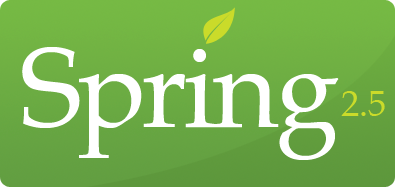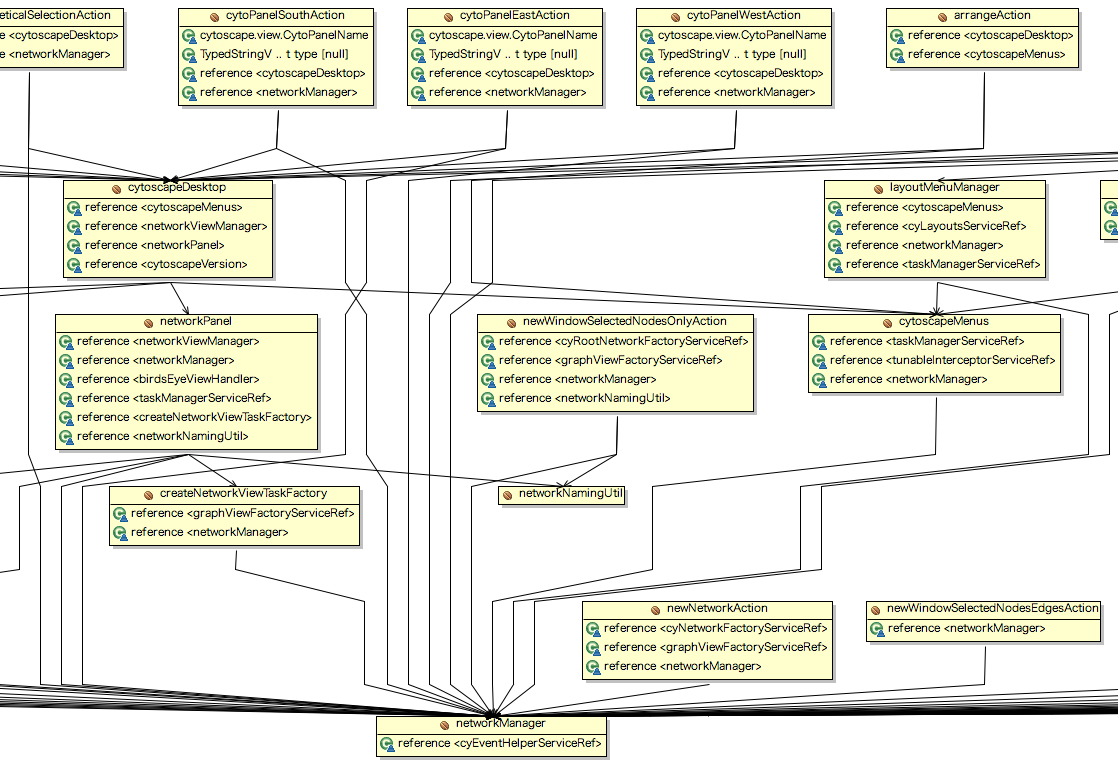


Cytoscape 3 Developer's Guide
Introduction
Cytoscape 3 is based on new technologies such as OSGi or Spring to provide maximum flexibility and expandability for all plugin writers. These technologies are very powerful, but you need to understand some new concepts to utilize them. The purpose of this document is to introduce new concepts you need to understand to develop Cytoscape 3 code and giving you a hands-on introduction to actual Cytoscape 3 code development.
Why Do We Have To Learn These New Technologies?
Cytoscape 2 has several architectural problems. They are:
- Modularity
- View and models are coupled in some places and hard to run in command line or server backend.
- Unnecessary packages are open to public access. The result is broken plugins every time core developer update some implementations.
- Expandability
- There are no mechanism for plugins to communicate to each other.
- Cytoscape crashes if different versions of a same library load at once.
The main purpose of new technologies we use is solving these problems.
OSGi
OSGi is relatively complex technology, but important points you need to understand for Cytoscape 3 development are only four:
OSGi framework manages modules as bundle. Bundle is a new kind of JAR files with set of metadata.
In Cytoscape 3, everything is a bundle. The border between plugin and core is very ambiguous.
- You can explicitly define which classes are accessible from others. Also, you can define which classes must be imported to run your bundle. This includes version numbers of the library, so different versions of the same library can exists on the same JVM.
You can export any object as OSGi Service to the OSGi Service Registry. All bundles can access those registered services.
These solves lots of problems we had in version 2.x:
Plugins developers can publish small set of public functions for other developers. If you define an OSGi manifest file (metadata for OSGi bundles), you can export only selected class(es) for other developers and hide all other classes EVEN IF THEY ARE PUBLIC CLASSES. Suppose you want to develop a plugin to find clusters in a large network. You want to make your clustering algorithms accessible from other plugin developers. In that case, all you have to do is exporting the following interface:
1 public interface ClusteringService {
2 // Run my clustering algorithm and return clusters as a set of CyNetwork
3 public Set<CyNetwork> getClusters(CyNetwork network);
4 }
5
If you export this as OSGi service, other developers can easily access your clustering algorithms programatically (or even from scripts because it's a part of Cytoscape 3 function). In addition, you can modify its implementation later without breaking other plugins because you are exposing interface (API) only and its implementation is completely hidden.
- Library version conflict
- In Cytoscape 2, the entire application sometimes crashes due to library version conflict. For example, if you use JAXB v2.0 in your plugin and other developer uses v2.1, the result is unpredictable. If we run Cytoscape on OSGi framework, this does not happen because you can specify which version of JAXB is required for your plugin and two different version of JAXB can run safely on the same JVM.
Spring Framework and Spring Dynamic Modules
Spring is the defacto standard of lightweight container for dependency injection. Tons of books and documents are available for Spring, and you can learn its mechanism by reading them. The role of Spring in Cytoscape 3 is simple: defining relationships between objects.
Wiring Objects

The diagram above shows the relationships between objects in Cytoscape 3 desktop application. In Spring, objects are defined as beans.

This diagram represents the cytoscapeDesktop bean, which is defined in a Bean Configuration XML file:
<bean name="cytoscapeDesktop" class="cytoscape.view.internal.CytoscapeDesktop">
<constructor-arg ref="cytoscapeMenus" />
<constructor-arg ref="networkViewManager" />
<constructor-arg ref="networkPanel" />
<constructor-arg ref="cytoscapeVersion" />
</bean>Cytoscape Desktop is the main GUI component which includes some other components such as Network Panel or Menu Bar. To create an instance of Cytoscape Desktop, we need to provide those objects prepared somewhere outside of it. Instead of creating new instances of those required objects or using static class,
Separate Implementation from API
Spring is a powerful tool, but if we use Spring Dynamic Modules (Spring DM), we can take advantage of both Spring and OSGi.
If we use Spring DM, Cytoscape 3 code is independent from OSGi API and Spring API. This means all of the Cytoscape objects are POJOs and we can replace the framework later when necessary.
The most important design concept you need to understand to develop Cytoscape 3 code is Interface-Oriented Design. Since Cytoscape 3 is a platform rather than a stand-alone desktop application,
Related Frameworks and Technologies
From 3.0, new technologies/frameworks will be used for implementation. The following is the list of links to documents related to those frameworks/technologies.
- OSGi - Cytoscape will be modularized by following this standard.
Apache Felix: Although OSGi is implementation-independent, this implementation will be used as standard development/testing tool.
OPS4J Products: This project has a lot of usuful scripts to develop OSGi bundles
SpringSource Bundle Repository: To use existing plain JAR libraries in an OSGi environment, we need to add metadata to it. This repository is a collection of OSGi-ed popular libraries, i.e., repository of OSGi bundles managed by Spring Source.
- Dependency Injection Frameworks - One of the scopes of 3.0 is modulalization and make Cytoscape usable as a part of other programs, including server-side application or command -line tools. The following DI frameworks are POJO-base and popular among server-side application developers.
Google Guice: Currently focused on DI only.
Spring Framework: De facto standard framework for DI and AOP.
Spring-DM: Integration of Spring Framework and OSGi
Apache Maven: 3.0 project will be moved from Ant to Maven.
Maven Repository Search - Note: Cytoscape cannot use most of these libraries directly. To use these, they should be re-packed as an OSGi bundle.
- Server-Side / SCA - Once Cytoscape is modulalized based on OSGi, we can use Cytoscape bundles and these frameworks to build server-side applications or web services.
Apache Tuscany: An open-source implementation of Service Component Architecture.
SpringSource Application Platform: OSGi-Spring powered application server.
- Scripting Language Support - There are several implementations of scripting languages running on JVM. These will be used to implement scripting feature in Cytoscape.
JRuby: Ruby scripting language running on JVM. Actively developed by Sun.
Rhino: JavaScript. Bundled with Java SE 6.
Jython: Python implementation.
Developer's Tutorials and References
For Eclipse Users
Basic Tutorial
Optional
Create Cytoscape 3 plugin from Maven Archetype (incomplete)
For Netbeans Users